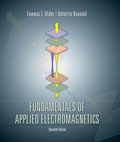
Concept explainers
Given
Want to see the full answer?
Check out a sample textbook solution
Chapter 3 Solutions
EBK FUNDAMENTALS OF APPLIED ELECTROMAGN
- In the circuit shown, let R₁-7, R₂-12, R3-24, R4-2, V₁ =17, V2 -68, and V3-51, to calculate the power delivered (or absorbed) by the circuit inside the box, as follows: {NOTE: On Multiple Choice Questions, like this problem, you have only one attempt } 1. The current I is equal to (choose the closed values in amperes) -0.791 0 -0.756 3.022 0.756 (A) -3.022 0.791 2. The power delivered (or absorbed) (choose the closest value in watts) (W) 373.345 0 -373.345 -52.234 52.234 65.079 O-24.833 R₁ V₂ R3 R₂ www V3 V₁ www R4arrow_forwardDetermine X(w) for the given function shown in Figure (1) by applying the differentiation property of the Fourier Transform. x(t) Figure (1) -2 -1 1 2arrow_forwardFor a enahnced-type NMOS transistor with V₁=+1V and kn'(w/L)= 2 mA/V2, find the minimum VDs required to operate in the saturation region when VGS=+2 V. What is the corresponding value of ID?arrow_forward
- . Using Properties to find the Z-Transform including the region of convergence for x(n) = n (2)" cos(0.2π(n − 2))u(n − 1) - -arrow_forwardJ VDD M₁ In the circuit of figure shown below, determine the region of operation of M₁as Vigoes from VDD.to zero. (You may want to draw a plot or just explain by the range, remember the transistor is a PMOS) Assume VDD = 2.5 V and | VTH | = 0.4V. 5 + 1 Varrow_forwardWe wish to design the circuit of the figure shown below for a drain current of 1 mA (l=1mA). If W/L = 18/0.18, compute R1 and R2 such that the input impedance is at least 20 k. R₁ VDD = 1.8 V 500 Ω M₁ R₂arrow_forward
- In the figure shown below, what is the minimum allowable value of VDD if M₁ must not enter the triode region? Assume λ=0 (use ideal current formula that is not dependent on VDs) 1 V + RD VDD = 1.8 V T M 500 Ω 1 W 10 L = 0.18arrow_forwardCalculate the total charge stored in the channel of an NMOS device if Cox=10fF/um², w=10 µm, L=0.1 μm, and VGS-VTH=1 V. Assume VDs=0. (means there is no movement of electrons, all of them are piled up in the channel, we want to calculate the magnitude of electron charge |Q|)arrow_forwardThe first photo is question 1arrow_forward
- a) Write down the order of the transfer function in each of the following cases. Assume that there are no terms in the numerator that will cancel terms in the denominator. 10 H(s) H(s) = s+1 5 (s+3)(s—. 4) 4s1 5 H(s) = H(s) - 83 +1 s27s 6 H(s) H(s) = s(s²+4s) 2s27s+1 84583882 +3s+2 H(s) 83 +8 s+1 = H(s) s34s26s+5 s52s4383 + 4s2 +5s +6arrow_forwardQuestion 5 ( A system is found to have zeros of -3 and poles of 4, and -2. The system also has a gain of 4. Write out the corresponding transfer function. Question 6. A system has a transfer function of What is the gain, K, of the system? Question 7 ( A system has a transfer function of H(s) - 4 8+5 H(s): = 4 8 +5 A step input of size 3 is applied to the system at time zero (Since we're dealing with transfer functions, x(0) is also zero at time zero). a) [10] What is the response ✗(s) of the system? b) [10] Derive the time dependent solution, x(t), of this responsearrow_forwardNote: You might want to do the last question first because the last question asks you to write some python code to calculate the zeros and poles. You could use that code here to help you (except the first problem which you should be able to do by inspection alone) Find the poles and zeros for each of the following transfer functions 1. S+3 H(s) = 8 5 2. H(s): = s238 +1 s2 +48 +3 3. s(s+4) H(s) s3+2s23s 4. 82-586 H(s) = - 8382-68 5. H(s): = s2 +48 +3 s45836s2 - 6arrow_forward
 Introductory Circuit Analysis (13th Edition)Electrical EngineeringISBN:9780133923605Author:Robert L. BoylestadPublisher:PEARSON
Introductory Circuit Analysis (13th Edition)Electrical EngineeringISBN:9780133923605Author:Robert L. BoylestadPublisher:PEARSON Delmar's Standard Textbook Of ElectricityElectrical EngineeringISBN:9781337900348Author:Stephen L. HermanPublisher:Cengage Learning
Delmar's Standard Textbook Of ElectricityElectrical EngineeringISBN:9781337900348Author:Stephen L. HermanPublisher:Cengage Learning Programmable Logic ControllersElectrical EngineeringISBN:9780073373843Author:Frank D. PetruzellaPublisher:McGraw-Hill Education
Programmable Logic ControllersElectrical EngineeringISBN:9780073373843Author:Frank D. PetruzellaPublisher:McGraw-Hill Education Fundamentals of Electric CircuitsElectrical EngineeringISBN:9780078028229Author:Charles K Alexander, Matthew SadikuPublisher:McGraw-Hill Education
Fundamentals of Electric CircuitsElectrical EngineeringISBN:9780078028229Author:Charles K Alexander, Matthew SadikuPublisher:McGraw-Hill Education Electric Circuits. (11th Edition)Electrical EngineeringISBN:9780134746968Author:James W. Nilsson, Susan RiedelPublisher:PEARSON
Electric Circuits. (11th Edition)Electrical EngineeringISBN:9780134746968Author:James W. Nilsson, Susan RiedelPublisher:PEARSON Engineering ElectromagneticsElectrical EngineeringISBN:9780078028151Author:Hayt, William H. (william Hart), Jr, BUCK, John A.Publisher:Mcgraw-hill Education,
Engineering ElectromagneticsElectrical EngineeringISBN:9780078028151Author:Hayt, William H. (william Hart), Jr, BUCK, John A.Publisher:Mcgraw-hill Education,





